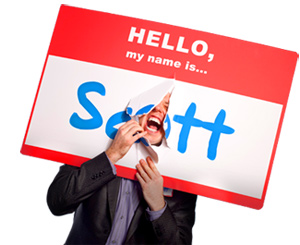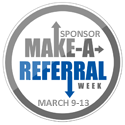1. Who has the best autoresponder you’ve ever heard?
2. When was the last time somebody complimented your autoresponder?
3. What could you possibly have to lose by making your autoresponder more fun, more memorable, more unexpected and more readable?
Three answers:
1. Not you.
2. Never.
3. Nothing.
HERE’S THE DEAL: Your autoresponder isn’t (just) an email.
It’s part of your brand.
It’s an extension of your values.
It’s the arbiter of your boundaries.
And yet, it’s one of the most commonly overlooked branding hotspots.
“Thank you for your email. Your message is important to me, so…”
Vlaargh.
And that’s the scary part. Some people send emails (just like this) over two hundred times a day.
That’s 50,000 times a year. That’s 50,000 instances of…
No value. No fun. No brand. No engagement. No honesty. No memorability. No humanity. No approachability.
Yikes.
Look, just because a computer sends the message doesn’t mean it has to SOUND like a computer.
On the other hand: What if your autoresponder was so good that people told their friends about it? So good that people actually printed out a copy of it to show to their boss?
Think that would boost business in a struggling economy?
Yep.
Here are seven ways to create an autoresponder that makes money, delivers value and reinforces your brand:
1. Roboticism doesn’t work. If you write like you talk, people will listen. What’s more, it will sound more human, which is an accomplishment when it comes to technology. So, try this: Before finalizing the language for your autoresponder, read it out loud. Run it by a few colleagues. Then, ask these two questions:
a. Does it sound like a human, or a Hewlett Packard?
b. Are there any words in this email I wouldn’t use in everyday conversation?
REMEMBER: These filters will keep your email approachable and real. How are you fully integrating your humanity into your autoresponder?
2. Keep it short. It’s an autoresponder, not an autobiography. People don’t care and they don’t have time.
REMEMBER: Actually, that’s it for this example. Does this email demonstrate a respect for others’ busy schedules?
3. Leverage your subject line. Avoid stock phrases like “Thanks for your email” and “Out of the Office.” Emails with subject lines like that will be ignore or deleted. Instead, try something unexpected like:
a. Include your brand mantra.
b. Ask people a question of the day.
c. Offer a famous quotation. (Hopefully one of YOUR quotations.)
d. “Please call if it can’t wait till 11am or 4pm.” (Thanks this out. How radically honest is your autoresponder?
5. Funny makes money. If you’re going to use your autoresponder to promote your business, that’s cool. My only caveat is that you keep it light, fun and maybe even a little humorous. This will diffuse the defensiveness of the sales environment. Here’s an excerpt from my autoresponder:
“Also, while you’re poking around www.hellomyanmeisscott.com, my humble request is that you: Buy all eight of my books, hire me to speak at your organization’s next meeting, order customized video learning modules from NametagTV.com and rent my brain for a one-on-one business coaching session.
Not necessarily in that order, of course.”
Interestingly, about 30% of my recipients email me back a second time just to compliment this “playful pitch.” And about 1% of them actually buys something or hires me. Cool!
REMEMBER: We live in a sales-resistant culture. How does your autoresponder disarm people? How could you leverage your autoresponder as client attraction tool?
6. Mix the medium. If the purpose of your autoresponder is to filter out email overload and optimize your time, consider offering people multiple options for contact. For example, you could write:
a. “If this is an emergency, please call the following number…”
b. “If you need to physically send me something, my address is…”
c. “My wonderful assistant, Stephanie, gets paid BIG bucks to spend her whole day helping people like you. Her email is [email protected]. She’ll take care of ya!”
REMEMBER: Not everybody likes email. Some prefer the phone. Some prefer snail mail. How many contact options does your autoresponder offer?
7. Deliver value. Access doesn’t always mean presence. You can still answer people’s questions by including helpful resources For example, you might offer a link to your FAQ page or downloadable ebook. Or a link to your travel calendar. What about an interview you recently did? That’d be unexpected.
REMEMBER: A response demonstrates a sense of urgency. It’s also helpful and brand-consistent. Does your autoresponder deliver value? What resource could you send people? How else could you help people in your absence?
– – –
THE BOTTOM LINE: Boring autoresponders are taking money out of your wallet.
50,000 times a year, remember?
Fun. Engagement. Value.
That’s what it’s about.
Memorability. Humanity. Approachability.
That’s what it’s about.
REMEMBER: Just because a computer sends the message doesn’t mean it has to SOUND like a computer.
Because it’s not just an autoresponder – it’s a mechanism for delivering value, declaring val-UES and solidifying boundaries.
LET ME ASK YA THIS…
Who’s printing out YOUR autoresponder and showing it to their boss?
LET ME SUGGEST THIS…
For the list called, “30 Ways to become the Most Interesting Person You Know,” send an email to me, and I’ll send you the list for free!
* * * *
Scott Ginsberg
That Guy with the Nametag
Author, Speaker, Coach, Entrepreneur
[email protected]
 The world’s FIRST two-in-one, flip-flop book!
The world’s FIRST two-in-one, flip-flop book!
Buy Scott’s comprehensive marketing guidebook on Amazon.com and learn how to GET noticed, GET remembered and GET business!











